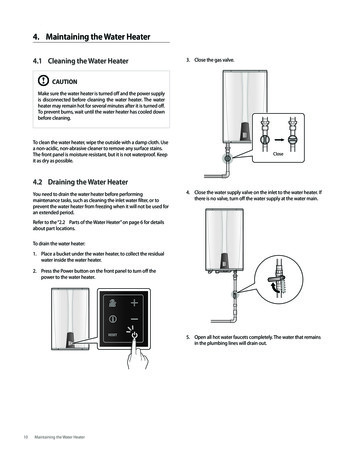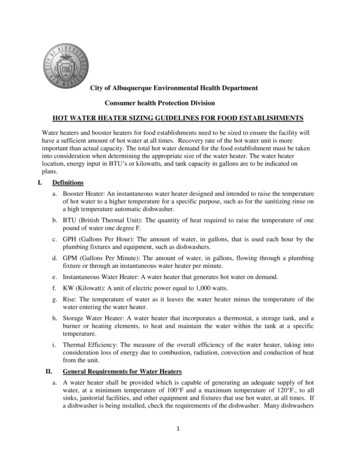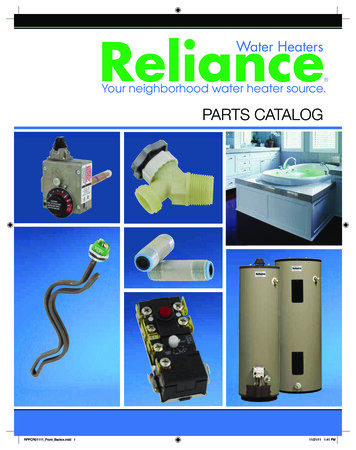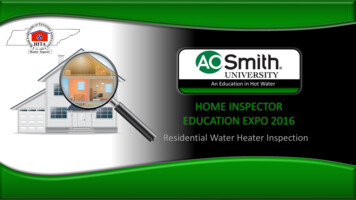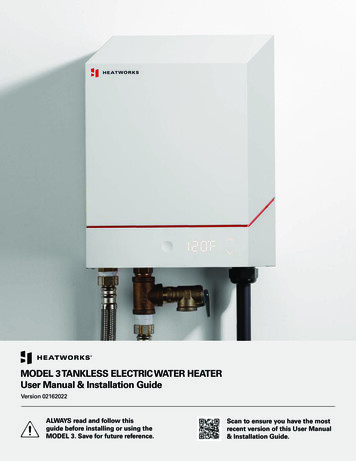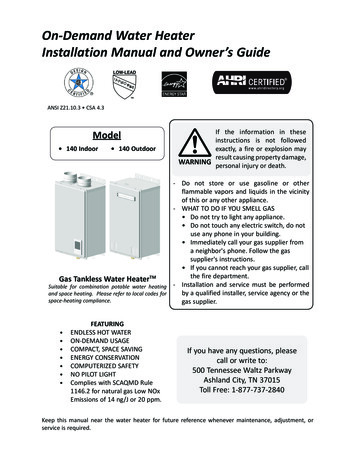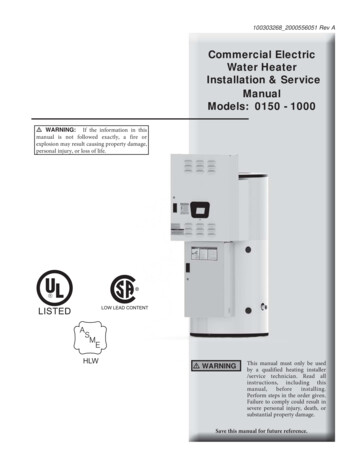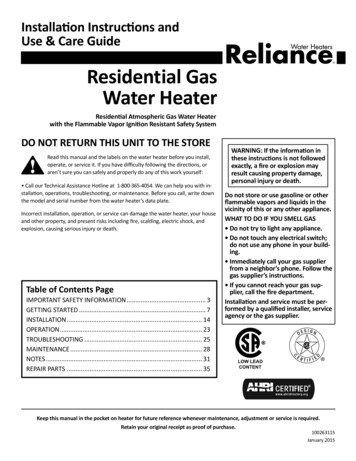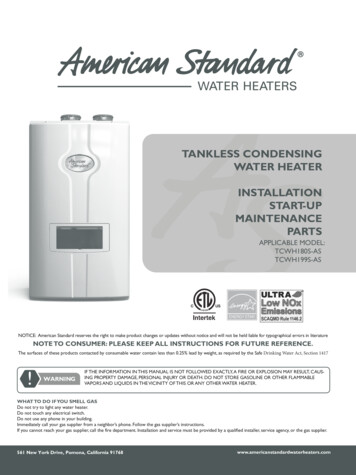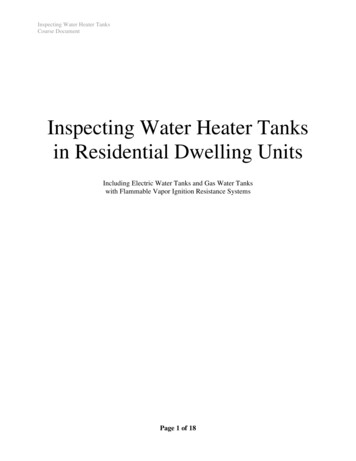
Transcription
Inspecting Water Heater TanksCourse DocumentInspecting Water Heater Tanksin Residential Dwelling UnitsIncluding Electric Water Tanks and Gas Water Tankswith Flammable Vapor Ignition Resistance SystemsPage 1 of 18
Inspecting Water Heater TanksCourse DocumentCourse title: “Inspecting water heater tanks in residential dwelling units.”Course objective: To obtain an understanding of how to inspect the water heater tanks in a singleresidential dwelling unit, including fuel and electric water heater tanks.Completing this course should enable an inspector to identify components of gas-fired and electricwater heater tanks, recognize defects and safety hazards in relation to modern standards andrequirements, explain how a flammable vapor ignition resistance system (FVIR) works, theimportance of temperature-and-pressure relief valves, and checking confined spaces.This is not a code compliance course. There are many codes, and they change regularly. This levelof inspection is beyond what an inspector would do on a general home inspection and exceedsInterNACHI's Standards of Practice.We will read text from modern building standards, we will apply those standards in a mock-upstudio setting, and then we will perform inspections of hot water tanks at existing residential homes.We will watch and learn from a master plumber as he inspects two hot water tanks - one gas andone electric.At the end of the course, we will go over some suggested language that can be used in an inspectionreport. An inspection report should describe and identify in written format the inspectedcomponents of the system and should identify defects that were observed.Page 2 of 18
Inspecting Water Heater TanksCourse DocumentWater Heater1.0 General CommentsA water heater is any appliance that heats potable water and supplies heated water to thedistribution system. Some water heaters can be used for space heating. Water heaters are potentialexplosion hazards if not properly installed. There are instances where hot water tanks withimproperly installed safety devices have been propelled through floor and roof structures and over100 feet into the air.Because of the potential hazards, there are standards that regulate the materials, design, andinstallation of water heaters and their related safety devices. Certification marks from approvedagencies on water heaters are required to indicate compliance with approved standards.Most tanks are insulated steel cylinders with an enamel coating on the inner surface. Theyare referred to as glass-lined tanks. The lining helps prevent corrosion. Conventional residentialwater heaters have life expectancies that vary greatly.2.0 Water Heater As a Space HeaterIf a water heater has a dual purpose of supplying hot water and serving as a heat source for ahot water space heating system, the maximum outlet water temperature for the potable hot watersystem is limited to 140 F (60 C). A master thermostatic mixing valve should be installed to limitthe water the water temperature to 140 F (60 C) or less.A water heater used as a part of a space heating system, such as an under-floor radiantsystem, must be protected from any conditions that could cause contamination of the potable watersystem. If the water heater is part of the potable water system, materials used in the heating systemmust be for use in a potable water system. The water potability must be maintained throughout thesystem. Chemicals of any type must not be added to the heating system, because this would directlycontaminate the water supply.3.0 Sacrificial RodWater circulating through a hot water circulation system becomes chemically inert and does notcorrode the piping. But water heaters have a constant supply of fresh water with lots of corrosioncausing oxygen. Because of this, water heaters are prone to corrosion. As a result, water heatersusually have an anti-corrosion rod or sacrificial rod installed. Sacrificial anodes are typicallymagnesium or aluminum. The rod is immersed inside the water heater tank, allowing the chemicalreaction from the fresh water to attack it rather than the tank. In some areas, rods are replacedregularly.Page 3 of 18
Inspecting Water Heater TanksCourse Document4.0 Drain ValveA water heater must have a drain valve installed for service, maintenance, sediment removal,repair, and replacement. The valve inlet is -inch (19 mm) nominal pipe size. The outlet is astandard -inch (19 mm) male hose thread and a straight-through waterway of at least -inch (13mm) diameter.5.0 AccessWater heaters should be accessible for routine inspections, maintenance, adjustment, repairs,and replacements. Manufacturers usually make access recommendations. “Accessible” means toreach the water heater by possibly first removing a panel, door, or similar obstruction. “Accessible”does not include the removal or destruction of finish materials, such as drywall, paneling, or built-incabinets. A walkway, workspace, or platform may be necessary to provide a safe access path totravel to and work on a water heater.6.0 Water Heater LabelingAll water heaters must be certified by a third party, approved agency, such as ANSI and UL.The certification mark indicates that the heater has been tested and has been determined to performsafely when installed and operated properly in accordance with the manufacturer’srecommendation. If the water heater is electric or oil, it should conform to UL standards. If it isnatural gas, it should conform to ANSI standards.The labeling on the hot water tank could list the manufacturer, the tank size, the serial number,model number, fuel type, BTU ratings, and proper clearances required for the tank.7.0 Pressurized Expansion TanksA pressurized expansion tank is a sealed cylinder divided by a flexible diaphragm. Anexpansion tank provides space for the water to expand as it is heated and assists in keeping thewater pressure in the normal pressure range while the water heater is operating.The expansion tank is designed and intended for water storage at a maximum pressure of 150psi and a maximum temperature of 200 F. This tank should be pre-charged at 40 psi. The tankshould not exceed 80 psi. air charge; otherwise the tank could be damaged. The tank can accept oneto three gallons of water, depending upon the tank size.The best location for installing an expansion tank is near the hot water source, hangingdownwards. The 2nd optional location is not hanging but standing upwards. The 3rd best optionallocation is a horizontal installation, but support straps are needed since the tank and water canweigh 15 to 35 pounds depending upon the size of the tank.Page 4 of 18
Inspecting Water Heater TanksCourse DocumentA “closed” water distribution system with a check valve installed on the main water linecoming into the house requires a thermal expansion control device, such as an expansion tank.When water heats up inside the tank, it expands. Since it cannot expand out to the street because ofa check valve, the expansion tank will absorb the expansion.8.0 Tankless Water HeatersTankless (point-of-use) water heaters have become increasingly popular in recent years forheating potable water in residential homes in the U.S. There are several major factors in the trendof installing tankless water heaters. One is an increasing demand for continuous unlimited streamsof hot water for simultaneous operation of hot water consuming appliances and fixtures. Another isa desire to save floor space and to conserve energy by reducing standby losses.There are many different models of fuel-gas and electric tankless water heaters, each having aspecific rating. Tankless water heaters are rated at so many gallons per minute (gpm) at so manydegrees of water temperature rise.8.1 Tankless Temperature ControlSince tankless water heaters can discharge water at an uncertain range of temperatures at anygiven time, depending on the use, a temperature control device is needed to protect the user fromscalding water being discharged. A tempering valve can be adjusted to deliver water at a maximumtemperature of 140 F (60 C), or the heater can be equipped with a temperature-limiting device orthermostat that has the maximum setting. When a tankless water heater supplies a shower ortub/shower combination, the maximum temperature of the outlet control valve of the shower ortub/shower must be at 120 F (49 C).8.2 Tankless SizeOne challenge in sizing a tankless water heater is to determine the demand in gallons perminute. The second challenge is determining what temperature rise is required for that flow.Because tankless water heaters are designed to accommodate a given maximum flow, there is apressure loss associated with flows in excess of a unit’s usable flow rating. In a house with atankless water heater, it’s possible to have a fixture with almost no flow of water if too manyfaucets are opened simultaneously. Occupants may have to adjust their expectations concerningwhen and to what extent simultaneous demands for hot water can be made before temperature andflow of hot water is affected.9.0 Tankless Coils in BoilersTankless coils are indirect method of heating potable water with the use of a boiler. A coldwater supply pipe extends into the hottest part of the boiler water. The water in the copper tube iskept hot by the boiler water. When there is demand for hot water, water flows through the tubethrough the hot boiler water, and water is delivered to the fixture.9.1 Indirect Water HeatersIndirect water heaters offer an efficient choice for many homes, even though they require a storagetank. An indirect water heater uses the main furnace or boiler to heat a fluid that's circulatedthrough a heat exchanger in the storage tank. The energy stored by the tank allows thefurnace/boiler to turn off and on less often, and that saves energy. Therefore, when an indirectPage 5 of 18
Inspecting Water Heater TanksCourse Documentwater heater is used with a high-efficiency boiler and well-insulated tank providing hot water can bevery inexpensive. Indirect systems can be gas, oil, propane, electric, solar energy, or a combination.10.0 Water Heater Tank LocationsInstallation of water heater tanks which use solid, liquid, or gas fuel should not be permitted ina room containing air-handling machinery when such room is used as a plenum. If there’s amalfunction of the water heater or its venting system, there is a potential for toxic combustionbyproducts to spread throughout the dwelling. The air-handling system can also produce negativeand positive air pressures and affect the drafting or venting of the water heater. The negativepressure produced by a plenum could overcome the natural draft of the heater’s venting system, andpull flue gases into the room.10.1 Located in Storage Closets, Bedrooms, and BathroomsFuel-fired water heaters should not be installed in a room used as a storage closet. Fuel-firedwater heaters should not obtain combustion air from sleeping rooms, bathrooms, or toilet rooms.There are two exceptions: 1) water heaters located in bedrooms or bathrooms could be installed in asealed enclosure so that combustion air will not be taken from the living space, and a solid weatherstripped door and a self-closing device should be provided; 2) water heater could be installed in aroom that is not a confined space and the building is not of unusually tight construction.10.2 Located in GaragesGasoline leakage or spillage in a garage is a possible danger. Gasoline fumes will evaporatefrom liquid puddles at the floor level. Any potential ignition source should be elevated to keepopen-flame or spark-producing elements above the gasoline fume level.A hot water tank with an open source of ignition should be elevated not less than 18 inches(457 mm) above the floor of a garage. There is an exception for appliances that are listed asflammable vapor ignition resistant (FVIR).10.3 Located in AtticsA suitable access opening, passageway, and work space is required when a water heater isinstalled in an attic. The opening, passageway, and workspace should be large enough toaccommodate the removal and replacement of a water heater.The access opening should be at least 20 inches by 30 inches (508 mm by 762 mm) to allow theremoval of the water heater.The passageway should be at least 30 inches (762 mm) high and 22 inches (559 mm) wide.The passageway should not be longer than 20 feet (6,096 mm) when measured along the centerlineof the passageway from the opening to the water heater. The passageway should have continuoussolid flooring not less than 24 inches (610 mm) wide.There should be a level workspace that is at least 30 inches (762 mm) deep and 30 inches (762mm) wide at the service-side of the water heater.11.0 Confined Space and Combustion AirConfined space. If the volume of space in which the appliance is located is less than 50 cubicfeet of space per 1,000 Btu per hour of aggregate input of the appliance, then it is a confined space.(50 cubic feet 2.5 ft. x 2.5 ft. x 8 ft.)Page 6 of 18
Inspecting Water Heater TanksCourse DocumentUnconfined space. In unconfined spaces in buildings, infiltration may be adequate to provideair for combustion, ventilation and dilution of flue gases. However, in buildings of tightconstruction (for example, weather stripping, heavily insulated, caulked, vapor barrier, etc.),additional air may need to be provided.Solution. Two permanent openings to adjacent spaces could be provided so that the combinedvolume of all spaces meets the requirements. If the building is sealed so tightly that infiltration airis not adequate for combustion, combustion air then should be obtained from outdoors.All air from inside the dwelling. If all combustion air is taken from the inside of the dwelling,then two permanent openings should be installed. One opening should be within 12 inches (305mm) of the top and one within 12 inches (305 mm) of the bottom of the space. Each opening shallhave a free area equal to a minimum of 1 square inch per 1,000 Btu/h (2201 mm2/kW) input ratingof all appliances installed within the space, but not less than 100 square inches (64415 mm2).All air from outdoors. If all combustion air is taken from the outdoor air, then one openingshould be within 12 inches (305 mm) of the top and one within 12 inches (305 mm) of the bottomof the space. The openings are permitted to connect to spaces directly communicating with theoutdoor air, such as a ventilated crawlspace or ventilated attic space. Each opening should have afree area of at least 1 square inch per 4,000 Btu/per hour (550 mm2/kW) of total input rating of allappliances in the space when using vertical ducts (2,000 Btu/per hour if using horizontal ducts).Louvers. In calculating the free area of combustion air openings fitted with louvers, metallouvers obstruct about 25 percent of the opening. Wooden louvers obstruct 75 percent.12.0 Seismic Supports for TanksIn those areas determined to have high earthquake risk, it is important that a water heater befastened in place with two straps to avoid damage. Strapping should be at a point within the upperone-third and lower one-third of the tank’s vertical dimension. At the lower point, the strappingshould maintain a minimum distance of 4 inches (102 mm) above the controls. Water heatersupports and piping supports should be designed to resist seismic loads. Failure of water heatersupports has been shown to be a threat to health and safety. In addition to strapping, approvedflexible connectors should be used.13.0 Water Valves for Water Heater TanksA valve should be installed on the cold-water branch line from the main water supply line toeach hot water storage tank or water heater. The valve should be conspicuously located and nearthe water heater, accessible from the same floor level as the water heater that it serves. The valve isto be installed so that if the heater is taken out of service, the other portions of the water distributionsystem are not disrupted.Page 7 of 18
Inspecting Water Heater TanksCourse Document13.1 Inspect the Valve.An inspector should verify that a full-open valve is installed on the cold water supply line.Full-open valves are shutoff valves that in the full-open position have a straight-through flowpassageway. Unlike shutoff valves and stops, full-open valves add little resistance to flow and littleeffect on supply pressure. Ball valve are commonly found at hot water tank. The handle clearlyshows whether the valve is open or closed.14.0 Dip Tube HoleA typical design of a water heater tank includes a cold-water ‘dip’ tube. The tube directs thecold water to the bottom of the tank. At the top of the tank, a hole is installed in the dip tube toprevent water from being siphoned from the tank through the tube. The hole is required to belocated within 6 inches of the top of the tank. A vacuum relief valve may be installed in lieu of anantisiphoning hole in the dip tube.15.0 Fuel Shutoff Valves or Electric DisconnectsA fuel shutoff valve is required for all fuel-fired water heaters. An electric disconnect shouldbe installed for all electric water heaters. They are necessary for service, repair, or emergencyshutdown.16.0 TPR ValvesCombination temperature and pressure relief (T & P Relief or TPR) valves do two things:1) they open and release water out of the tank if the temperature exceeds 210 F (just below theboiling point), and 2) they will open if the pressure in the tank exceeds 150 psi (the maximumnormal operating pressure for a water heater.)Relief valves must be third-party tested. The certification mark is the indicator that the valvehas been tested. Temperature relief valves must be set at a maximum temperature of 210 F (99 C).The valve is designed to dissipate energy at a rate (BTU rating) equal to or greater than theenergy/heat input rate (BTU rating) of the water heater. A relief valve opens in proportion to thetemperature and pressure forced upon its closure disk. The higher the temperature or pressure, thegreater the force, and the more the valve opens.The valve must be set to 25 psi (172 kPa) above the system, but not over 150 psi (1035 kPa).This setting should not exceed the tank’s rated working pressure. An undersized valve would not beable to prevent pressure from exceeding the maximum capacity, and a dangerous situation couldresult. The result could be an explosive tank rupture accompanied by an instantaneous release ofenormous thermal energy stored in superheated water inside the tank. It could propel a water heaterlike a rocket through multiple stories and the roof of a dwelling.A temperature and pressure relief (T&P Relief or TPR) valve should be installed on all storagewater heaters operating above atmospheric pressure. Tankless water heaters must have TPR valvesinstalled. Water heaters without this protection can produce explosions and have been responsiblefor many deaths.Boilers should be equipped with pressure-relief valves with minimum rated capacities forthe equipment served. A boiler operates at a maximum water pressure of 160 psig and at amaximum water temperature of 250 F (121 C). Pressure-relief valves should be set at themaximum rating of the boiler. Discharge should be piped to drains by gravity to within 18 inches(457 mm) of the floor or to an open receptor.Page 8 of 18
Inspecting Water Heater TanksCourse DocumentSome gas water heaters use temperature cut-outs, such as the Watts 210 valve. This is avalve installed in the gas supply line to the water heater. There is a temperature probe in the top ofthe water heater. The Watts 210 valve will shut off the gas supply to the water heater if the watertemperature exceeds 210 F. Once the water is cooled, the valve can be reset manually to restore thegas flow.16.1 Location of TPR Valve on Hot Water TankIn order to properly sense the tank’s water temperature, the TPR valve should be located in thetank water in the upper 6 inches of the hot water tank, where all of the hottest water is located. Thelocation is more important for temperature than pressure, since the pressure is uniform throughoutthe tank. To prevent heating the water above 210 F, the TPR valve must be installed in the hotwater within the top 6 inches of the tank. Typically water heater tanks have an opening in the tankshell installed by the manufacturer.16.2 Relief Valve ImportanceWater is essentially an incompressible solid. It has no latent heat energy within itself toexpand when released, unless the water is superheated. Water above 212 F is superheated water,and superheated water would really like to turn into steam at atmospheric pressure. It possesseslatent heat energy, which can flash into steam and create a force that is not unlike an explosion.Water would normally boil at 212 F, but inside a tank it can’t expand anywhere so it can’tboil off into steam. Water in a “closed” system and under pressure, such as inside a hot water tank,has a much higher boiling point. For example, where water supplied to a tank is at 50 psi, theboiling point is 297.7 F.Let’s assume a water heater tank has 30 gallons of superheated water inside it. Assume 50psi and the water temperature is superheated at 300 F. Remember that superheated water reallywants to turn into steam. If the tank ruptures, then 30 gallons of superheated water willinstantaneously turn into steam in an outwards direction through the rupture.There is a tremendous amount of energy released as the superheated water is exposed toatmospheric pressure and immediately turns into steam. Every cubic inch of water becomes a footof steam!Below is a chart showing the explosive energy created in a 30 gallon hot water tank atvarious pressures and temperatures.Page 9 of 18
Inspecting Water Heater TanksCourse DocumentEnergies developed in a 30-gallon hot water tankPressureWater will boil atFoot-pounds of energy released when30 gallons of water is exposed topsiatmospheric pressure0212.0 F010239.5 F479,80030274.0 F1,305,00050297.7 F2,021,90070316.0 F2,642,00090331.2 F3,138,400Note that at 50 psi, water flashes into steam at 297.7 F, and the energy released equals morethan 2 million foot-pounds of energy, similar to the explosive energy released by one pound ofNitroglycerin. A 16-inch gun on a USS Iowa class battleship produced a 7,500,000 foot-pounds ofenergy.This is why it is essential to avoid excessively high water temperatures and pressures at awater heater tank.17.0 Expansion Tank on a BoilerHot water boilers should be provided with expansion tanks. There are two types of expansiontanks for use with the residential boiler system. A nonpressurized tank is simply a cylinder filledwith air at atmosphere pressure. A pressurized tank is a sealed cylinder divided by a flexiblediaphragm. An expansion tank provides space for the water to expand as it is heated and keeps thewater pressure in the normal operating range while the boiler is operating.18.0 Discharge Pipe on T&P Relief ValveThere are thirteen requirements for a discharge pipe serving a TPR valve. They are as follows:1) The pipe should not be directly connected to the drainage system;2) The pipe should discharge through an air gap located in the same room as the water heater;3) The pipe should be constructed of materials tested, rated, and approved for such use;4) The pipe should not be smaller than the diameter of the outlet of the valve served and shoulddischarge full size to the air gap;5) The pipe should not have valves or tee fittings installed;6) The pipe should not have a threaded end;7) The pipe should serve a single relief device and should not connect to piping serving anyother relief device or equipment;Page 10 of 18
Inspecting Water Heater TanksCourse Document8) The pipe should discharge to the floor, to an indirect waste receptor or to the outdoors.Where discharging to the outdoors in areas subject to freezing, discharge piping should be firstpiped to an indirect waster receptor through an air gap located in a conditioned space;9) The pipe should not terminate more than 6 inches (152 mm) above the floor or wastereceptor;10) The pipe should discharge in a manner that does not cause personal injury or structuraldamage;11) The pipe should be installed so as to flow by gravity;12) The pipe should discharge to a termination point that is readily observable by the buildingoccupants; and13) The pipe should not be trapped.The termination of a relief valve discharge pipe should always be visible and conspicuous. Anair gap is necessary to prevent backflow and contamination of the potable water system. Thedischarge pipe must not be reduced in size, and must not be less than the size of the relief valveoutlet. A reduction in size will act as a restriction and would impede the flow rate of the discharge.Relief valves must not be exposed to freezing temperatures. The slow drip of a leaking valve infreezing temperatures would cause ice to form and restrict the discharge and disable the valve.The discharge pipe should have a minimum pressure rating of 100 psi (690 kPa) at 180 F (82 C). Water heater temperature-relief valves are usually set to open and discharge at 210 F (99 C).19.0 Water Leak Catch PanA water heater tank should be installed inside a pan in locations in a dwelling where a leakfrom the tank could cause damage to the structure or property. The pan is intended to catch waterleaks from the tank or associated connections, or condensate from the tank.The pan should be galvanized steel or other listed material for that use, with a minimumthickness of 24-gauge (0.016 inch) (0.4 mm). Prefabricated aluminum and plastic pans are commonand widely used. Aluminum and plastic pans may not be allowed by the authority havingjurisdiction (AHJ) or code official, because they are not galvanized steel. Some tank manufacturersrequire the use of a metal pan only.A relief-valve pipe terminating into a water leak catch pan is not permitted, because the pan isnot an indirect waste receptor. Most pans have only a inch-diameter (19 mm) drain outlet, whichis not capable of gravity draining the pressurized discharge of the relief valve at full flow.The pan should not be less than 1.5 inches (38 mm) deep. The pan should be of sufficient sizeand shape to catch all dripping water or condensate leaks. The pan should be drained by an indirectwaste pipe having a minimum diameter of inch (19 mm). The pan drain must not be reduced inPage 11 of 18
Inspecting Water Heater TanksCourse Documentsize over its entire length, because a reduction will act as a restriction and will impede thedischarge.The pan must not connect directly to the drainage system. The pan should terminate over asuitably located indirect waste receptor or floor drain or extend to the exterior. An air gap must beprovided to prevent backflow when the pan drain terminates into an indirect waster receptor or afloor drain. When the pan terminates to the exterior of the dwelling, it should terminate at least 6inches (152 mm) and at most 24 inches (610 mm) above the adjacent ground surface. This makesthe pan low enough not to be a nuisance and high enough to prevent the pan drain from becomingblocked by vegetation, snow, and ice.20.0 Defects at a Water Heater TankCheck for physical damage to the tank, particularly rust and corrosion on the bottom of thetank. Check for water marks on the floor of the tank. Check for a leaking TPR valve. The covers atthe electric heating elements should not be disturbed. Corrosion can be found where the water pipesare connected to the top of the tank. The electricity or the fuel may be shut off. There could bescorching at the burner cover area. The heat roll out shield should be in place. Confirm that thedrip tube is installed. The draft hood and vent connector are often loosely attached. All tanksshould be accessible with at least 24 inches (609 mm) of working space around them. Check theburner and flame. A damaged baffle (helix) could fall down on the burner.Tankless coils inside boilers can leak. The coil can damage the boiler. The coil is prone toclogging. There should be a temperature control valve installed to control the scalding watercoming from the coil in the boiler.21.0 Hot WaterHot water is defined as water of a temperature of 110 F (43 C) or greater. Tempered waterranges from 85 F to 110 F (29 C to 43 C), and the device supplying the tempered water must limitthe temperature to 110 F (43 C).If the distribution piping distance between the hot water source and any fixture is greaterthan 100 feet (30,480 mm), then the hot water supply system should have a method of maintainingthe temperature of the water. Otherwise, water is wasted at the point of use while the user iswaiting for the desired temperature to be reached.Pipe insulation is not required on all hot water distribution pipes, but insulation of the hotwater distribution pipes on a return circulation system should be installed.22.0 Flammable Vapor Ignition Resistant (FVIR) Water HeaterIn 2003, a new standard for water heaters was developed and phased in. It says, “The waterheater should not ignite flammable vapors outside the water heater created by the spilling ofgasoline onto the floor.” The Consumer Products and Safety Commission found thousands of fires,Page 12 of 18
Inspecting Water Heater TanksCourse Documentinjuries and deaths were related to water heaters. Most of these cases were because of improperstorage or handling/spillage of gasoline.If the tank is in compliance with the FVIR standards, it does not have to be raised 18 inchesin garages or similar locations, unless required by the manufacturer or local code authorities.A FVIR water heater has the following components: 1) a device to prevent ignited vaporsfrom passing out of the combustion chamber, 2) a one-way intake system to control the movementof makeup air into the combustion chamber, 3) an inner door and burner assembly to create a sealedjunction with the combustion chamber, pr
water heater is used with a high-efficiency boiler and well-insulated tank providing hot water can be very inexpensive. Indirect systems can be gas, oil, propane, electric, solar energy, or a combination. 10.0 Water Heater Tank Locations Installation of water heater tanks which use solid, liquid, or gas fuel should not be permitted in
